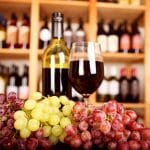If you’re looking for a red wine to serve with a meal, at a gathering, or just looking for a new bottle to try, Syrah and Zinfandel are both amazing options!
However, while these wines are different, at first glance they can appear rather similar. That makes it tough to know which one you want!
If you want to learn more about what differentiates these two wines, this is the article for you. We’ll cover everything you need to know to make your choice, including:
- An overview of Syrah and Zinfandel
- A detaileld comparison between the attributes of the two wines
- Pairing Syrah and Zinfandel with food
- How to make the choice between Syral and Zinfandel.
Let’s get into it!
Understanding Syrah: The Deep and Spicy Red

Syrah originated in the Rhône region of France and has been grown there for a long time, though its exact date of origin is not known.
Legend has it that it was brought to Europe in ancient times from the city of Shiraz in Iran, which was then the capital of the Persian Empire. In fact, the wine is still often called Shiraz!
Another theory claims it was brought from Syracuse, which is why it was given its name. However, it certainly laid its roots in Northern Rhône and is still grown there to this day.
In the 1830s, James Busby brought Syrah cuttings from Europe to Australia where it quickly established popularity. It’s actually still the most popular red wine grape in all of Australia, though it is grown all over the world today.
Syrah is known for its high tannin, acidic flavor with deep rich notes of blackberry, dark chocolate, and stone fruit. When grown in warmer climates, it gets sweeter and spicier.
Zinfandel: California’s Red Star
Zinfandel has its origins in Italy, where it is known as Primitivo in reference to the fact that the grapes often mature earlier than other wine-making varieties. However, it is best known for its strong ties to California wine country.
Zinfandel vines were brought from Europe to the east coast and then across the country to California during the gold rush in the 1850s.
It quickly spread and became massively popular in the late 1800s and into the early 20th century.
However, during prohibition sales of wine became illegal, and Zinfandel grapes proved difficult to cultivate and ship unprocessed – leading to the destruction of many crops and replaced with more resilient grape varieties.
This caused Zinfandel to remain unpopular and undergrown for decades after prohibition ended. However, this changed going into the 21st century, and this classic California wine is on the rise again.
This lush red wine is bright and fruity, with notes of raspberry and strawberry. When grown in warmer climates, it tends to have peppery, dark fruit, and aniseed flavors as well.
Comparing the Titans: Syrah vs Zinfandel

Generally, Syrah is dark, red-purple in color, while Zinfandel is slightly brighter and more translucent.
While both wines have fruity notes, the fruits match the colors with Syrah tasting of blackberry, plum, or dark cherry, and Zinfandel tasting of bramble berry, raspberry, and other tangy fruits.
Syrah has a higher tannin level, making it drier and more acidic with a larger potential for aging. Fine, aged Syrah often gains deep notes of leather and earth. This fuller body lends Syrahs a thicker mouthfeel, occasionally leaving the tongue feeling dry.
In contrast, Zinfandel has softer medium tannin levels, making it bright, fruity, and sweet. This makes them smoother and clearer tasting, as well as more refreshing.
Some spicier Zinfandels are also quite strong for wine, going up to around 16% ABV. Meanwhile, Syrah generally stays around 13 -14% regardless of vintage.
Key Flavor Notes in Syrah
While Syrah varies based on where it is grown, it is often reported to have complex, dry, and deep flavors. Some commonly suggested tasting notes are:
- Blackberry
- Dark cherry
- Dark chocolate
- Mint
- Eucalyptus
- Smoked meat
- Liquorice
- Cloves
- Espresso.
Key Flavor Notes in Zinfandel
Zinfandels are bright, sweet, and fruity, though they sometimes develop spicier notes. They are often reported as tasting of:
- Jams
- Cherry
- Raspberry
- Plum
- Black pepper
- Cranberry
- Boysenberry
- Oak
- Tobacco.
Pairing Syrah and Zinfandel with Food

The taste of Syrah can vary widely based on the climate it’s grown in. Cool climate (like French) Syrah is lighter-bodied with more savory flavors. This makes it pair excellently with grilled foods – try out lamb or gyros, eggplant, or capsicum!
Warm climate Syrah (Australian, South American) is more full-bodied with fruitier notes. This bolder wine can be paired with heavier flavors like red meat, barbecues, spicy foods, and Asian cuisine.
As Zinfandel is a bold wine, it shares similarities with full-bodied Syrahs in terms of pairings and also goes well with barbecue as well as with burgers, sloppy joes, and roast turkey or chicken.
It’s also a good pairing with meaty and tomato-based pasta and pizzas. Try fatty, salty appetizers as well, such as olives, garlic bread, or even French fries!
In general, Zinfandels are a more forgiving wine regardless of vintage, so don’t be afraid to experiment.
Syrahs pair well with harder, more pungent cheeses such as blue cheeses like gorgonzola or stilton, smoked gouda, and parmesan.
On the other hand, Zinfandel is excellent with blue cheese and goudas as well but generally leans towards saltier and fattier cheeses like cheddar, feta, and grilled halloumi.
Syrahs goes excellently with complex, rich desserts like dark chocolates, coffee-flavored desserts, and caramels. As Zinfandels are more versatile, they go great with most sweets, especially vanilla, cream, and fruit-based desserts.
Choosing Between Syrah and Zinfandel
In brief: if you’re after a complex, high tannin red, choose a Syrah. However, if you’re looking for a fruity, sweeter red, go with the Zinfandel!
Syrahs can sometimes be seen as a more sophisticated choice, while Zinfandels are fun and strong. However, it really does vary from bottle to bottle, as well as the region where the wine was grown.
When choosing which wine to buy, consider what food you’re serving, what the occasion is, and your or your guests’ tastes.
A carefully selected bottle of Syrah might be the better choice for a set menu, sit-down, carefully paired meal, while a Zinfandel may be more suited to bring to a dinner party where you don’t know what’s being served.
At the end of the day, there’s no harm in buying a bottle of each and seeing what you prefer!
Conclusion
Both Syrah and Zinfandel are delicious wines with a rich history and many fans.
While Syrah is more full-bodied and complex, Zinfandel tends to be more fruity – lending the wines to different food pairings and occasions for popping a bottle.
However, both wines are amazing in their own right, and we’re sure you’ll find one you love!
- White Wine Storage Temperature: Key to Perfect Preservation - December 19, 2023
- Syrah vs Zinfandel: Difference Between Two Red Titans - November 24, 2023
- Riesling and Moscato Face-Off: Comparing Sweet Wines - November 22, 2023










